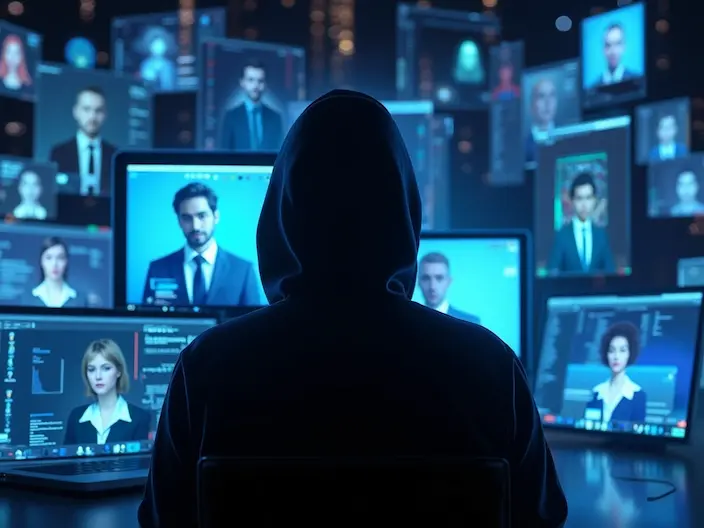Table of Contents
- Introduction
- Definition of Avatar and Its Importance in Virtual Worlds
- The Concept of Avatar
- The Importance of Digital Identity in Virtual Worlds
- Avatar Identity Theft: Concepts and Methods
- Definition of Avatar Identity Theft
- Methods of Identity Theft in Virtual Worlds
- Avatar Forgery
- Account Hacking
- Use of Personal Data
- Identity Change in Social Interactions
- Illegal Commercial Uses
- Selling Avatars and Related Assets
- Facilitating Factors of Avatar Identity Theft
- Weak Security Systems
- Lack of User Awareness
- Technological Advances
- Absence of Clear Legal Frameworks
- Growth of Illegal Markets
- Social Pressure for Online Presence
- Social and Psychological Consequences
- Impact on User Trust
- Psychological Consequences
- Anxiety and Stress
- Loss of Reputation
- Shame and Damage to Self-esteem
- Loneliness and Isolation
- Fear of Digital Future
- Sense of Insecurity in Real Life
- Legal Analysis
- Existing Laws on Identity Protection
- Legal Challenges in Virtual Worlds
- Lack of Clear Legal Definitions
- Difficulty in Assigning Responsibility
- Technical Issues in Identifying Perpetrators
- Lack of International Cooperation
- Delay in Updating Laws
- Proposed Legal Solutions
- Development of Comprehensive Laws
- Creation of Specialized Regulatory Bodies
- Encouraging the Use of Secure Technologies
- Establishing International Agreements
- Increasing Public Awareness
- Development of Anti-forgery Technologies
- Supporting Victims
- Conclusion
Introduction
With the rapid advancement of Virtual Reality (VR) technologies and the widespread adoption of virtual worlds, avatars have become an inseparable part of users’ identities. Avatars, as digital representations of users, enable communication and social, commercial, and even personal interactions in these worlds. However, this dependence on avatars has created a new arena for identity theft, resulting in new and complex legal consequences. This paper examines avatar identity theft, its social and psychological impacts, and the legal gaps related to the protection of these identities.

Definition of Avatar and Its Importance in Virtual Worlds
- The Concept of Avatar
An avatar is a digital representation of an individual’s character and identity, designed for interaction in virtual worlds. This concept can include simple 2D images, cartoon characters, or even advanced 3D models with dynamic capabilities. Some avatars are created using real user data, such as facial or body scans, offering an accurate portrayal of the individual’s real-world identity. On the other hand, some avatars are designed creatively and may bear no resemblance to the actual user.
- The Importance of Digital Identity in Virtual Worlds
With the advancement of technologies such as the metaverse, avatars have evolved beyond simple digital representations, becoming tools for expressing personality, engaging in business activities, and even forming social relationships. Avatars enable participation in virtual conferences, professional presentations, and interactions with clients or colleagues in a manner that feels closer to reality. These roles have made avatars valuable assets, necessitating legal protection and cybersecurity. Moreover, digital identity holds cultural and social significance as it allows users to redefine their identities in a space with fewer physical and social constraints.
Additionally, 3D digital identity is increasingly important as part of the future of human society. As the metaverse expands in fields like education, healthcare, commerce, and entertainment, the need for 3D identity to effectively participate in these spaces becomes even more pronounced. In the future society, 3D digital identity will be a critical tool for communication, transactions, and participation in social and professional activities. This new need calls for the creation of legal frameworks and supporting technologies to ensure the security and integrity of these identities.

Avatar Identity Theft: Concepts and Methods
- Definition of Avatar Identity Theft
Avatar identity theft refers to the unauthorized use of a person’s name, image, or any information related to their digital identity in virtual worlds. This theft can involve forgery, both commercial and personal uses, and even social misuse. In such cases, an individual or group exploits someone’s digital identity without their consent for purposes such as fraud, reputation manipulation, or engaging in illegal activities. This type of theft can cause significant harm to the victim, including damage to social reputation, financial loss, and even legal consequences.
- Methods of Identity Theft in Virtual Worlds
- Avatar Forgery: Creating similar or identical versions of a person’s real avatar using available data. This method involves redesigning or precisely reconstructing the victim’s avatar, which can mislead others.
- Account Hacking: Unauthorized access to an individual’s account with the aim of exploiting their avatar and digital identity. Hackers use this method to alter profile information, use the avatar in illicit activities, or steal digital assets.
- Use of Personal Data: Utilizing sensitive user information, such as biometric data (facial scans, voice, or body movements), to create similar avatars or fully forge identities. This method can be the most dangerous form of identity theft, as it involves advanced technology to recreate the victim’s identity accurately.
- Identity Change in Social Interactions: Some individuals may use a fake avatar to participate in social or professional events and, by impersonating the victim, jeopardize their credibility or social relationships.
- Illegal Commercial Uses: Avatars may be used in advertising or commercial campaigns without the original owner’s knowledge or consent. This type of theft can lead to financial and reputational damages.
- Selling Avatars and Related Assets: In some cases, stolen digital identities are sold as valuable assets in illegal markets. Buyers of these identities may use them for fraudulent purposes or other unlawful activities.

- Facilitating Factors of Avatar Identity Theft
- Weak Security Systems: Many virtual world platforms lack strong security protocols. These vulnerabilities include inadequate data encryption, lack of multi-factor authentication, and absence of monitoring systems to detect unauthorized activities. These weaknesses increase the likelihood of exploitation by attackers.
- Lack of User Awareness: Many users are unaware of the risks associated with sharing sensitive information. Sharing personal images, biometric data, or account information on virtual platforms can provide easier access for hackers.
- Technological Advances: Emerging technologies such as artificial intelligence, deep learning, and augmented reality (AR) and virtual reality (VR) have provided powerful tools for creating and manipulating avatars. These advancements enable criminals to create avatars that are complex and lifelike.
- Absence of Clear Legal Frameworks: The lack of comprehensive legal frameworks for protecting digital identities and avatars allows offenders to exploit legal loopholes. This undermines the victims’ motivation to pursue legal action for identity theft cases.
- Growth of Illegal Markets: The increased demand for digital identities in underground and illegal markets encourages criminals. These markets operate through anonymous and untraceable platforms, facilitating the spread of such crimes.
- Social Pressure for Online Presence: Social pressure and the need to engage in virtual worlds push more individuals to publicly share their avatars. This increases the likelihood of identity theft due to greater exposure.

Social and Psychological Consequences
- Impact on User Trust
Avatar identity theft can reduce users’ trust in the security of virtual worlds, decreasing their engagement in social and economic activities. Victims of this type of theft may feel that virtual worlds are unsafe environments for interaction and expressing personal identity. This loss of trust could lead to decreased public participation in these spaces and reduced growth rates of metaverse platforms.
- Psychological Consequences
- Anxiety and Stress: Victims may feel powerless or vulnerable. Losing control over their digital identity can lead to anxiety and even depression.
- Loss of Reputation: Fake identities can tarnish the victim’s social and professional credibility. People may wrongly believe that the victim participated in illegal or unethical activities.
- Embarrassment and Damage to Self-Esteem: Many victims feel embarrassed that their identity was exploited, which can lead to a decrease in self-esteem.
- Loneliness and Isolation: The social consequences of identity theft may drive victims to withdraw and avoid social activities. This isolation can have long-term negative effects on personal and social relationships.
- Fear of the Digital Future: Experiencing digital identity theft can create a lasting fear of using new technologies and virtual worlds. This fear may prevent victims from fully benefiting from digital opportunities.
- Insecurity in Real Life: The consequences of identity theft can extend beyond virtual worlds and create feelings of insecurity and concern about the safety of the victim’s real-life security.

Legal Analysis
- Existing Laws on Identity Protection
Laws related to digital identity protection are still in the early stages of development in many countries. Despite efforts to strengthen privacy and data protection laws, such as the General Data Protection Regulation (GDPR) in Europe and the California Consumer Privacy Act (CCPA), these laws do not specifically address the protection of avatars and digital identities in virtual worlds. Some of these laws focus on protecting personal data, but they ignore the cultural, social, and commercial aspects of digital identity.
- Legal Challenges in Virtual Worlds
- Lack of Clear Legal Definition: In many legal systems, the concept of an avatar or digital identity is not clearly defined. This causes confusion in courts and legal authorities when handling digital identity theft cases.
- Difficulty in Determining Responsibility: In virtual worlds, it is challenging to determine responsibility between users, platforms, and developers. This issue can lead to confusion in legal follow-up and the distribution of liability.
- Technical Issues in Identifying Offenders: Virtual worlds, using encryption technologies and anonymous systems, have made it extremely complex to identify offenders.
- Lack of International Cooperation: Avatar identity theft often occurs across borders, and national laws cannot effectively address the issue. The lack of coordination between governments and international bodies has made it easier for criminals to exploit legal gaps.
- Delay in Updating Laws: The rapid pace of technological advancement has outstripped the speed at which laws are updated, leaving existing frameworks unable to handle new issues.
- Proposed Legal Solutions
- Enacting Comprehensive Laws: Developing national and international laws that comprehensively address the concept of digital identity and avatars in virtual worlds. These laws should precisely define terms like avatars, digital identity, and data ownership. The laws must clarify the responsibilities of platforms, users, and developers in cases of identity rights violations.
- Establishing Specialized Regulatory Bodies: The establishment of regulatory bodies to oversee infractions related to avatars and virtual worlds is necessary. These bodies could help identify cases of identity theft, offer preventive solutions, and facilitate legal follow-up processes.
- Encouraging the Use of Secure Technologies: Laws mandating platforms to adopt advanced security technologies could reduce the likelihood of identity theft. These laws might require multi-factor authentication and encryption of data.
- Creating International Agreements: Coordination among countries through international agreements to combat cybercrimes and digital identity theft is vital. These agreements could facilitate legal and technical cooperation and prevent criminals from evading the law.
- Increasing Public Awareness: Laws could require platforms to educate users about the risks and methods of protecting their digital identity. This education could be provided through public campaigns, online courses, or platform-specific information.
- Developing Anti-Forgery Technologies: Investing in the research and development of tools to detect identity forgery and recognize fake avatars is crucial. These technologies could use artificial intelligence to monitor and analyze activities, issuing alerts when a violation is detected.
- Supporting Victims: Creating support centers for victims of digital identity theft that offer legal and psychological counseling can reduce the negative impacts of these crimes and help restore user trust.
Conclusion
Avatar identity theft has become a major challenge in virtual worlds. This issue not only has widespread social and psychological consequences but also exposes the legal gaps that hinder the effective protection of users’ digital identities. Enacting comprehensive laws, developing security technologies, and increasing public awareness are key solutions to tackle these challenges. Protecting users’ digital identities will not only enhance the security of virtual worlds but also foster greater trust in these technologies and ensure their sustainable growth.
Table of Contents
Toggle


One Response